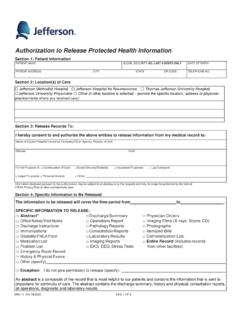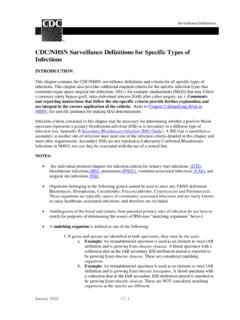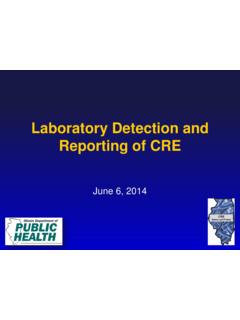Transcription of NURSE DRIVEN FOLEY CATHETER PROTOCOL - Jefferson …
1 NURSE DRIVEN FOLEY CATHETER PROTOCOLBACKGROUND There are over million hospital-acquired infections in US hospitals annually, 40% of which are urinary tract infections. 80% of hospital-acquired UTIs are attributable to indwelling urethral catheters. Between 12% and 25% of all hospitalized patients in the US will have a urinary CATHETER during their hospital stay, almost half of which are not placed for an appropriate indication. The duration of catheterization is directly related to risk for developing a UTI. The daily risk of developing a CATHETER - associated UTI (CA-UTI) ranges from 3-7%. TJUH began working on reducing CA-UTIs in 2008. NURSE DRIVEN FOLEY PROTOCOL (NDFP) is the next step in this processBackground Centers for Medicare and Medicaid Services estimates that the cost of CA-UTI is between $424 and $451 million annually.
2 Beginning on October 1, 2008 CMS no longer pays for preventable hospital-acquired complications including CA-UTI. CA-UTI received a high priority because of its high cost, high volume, and because it can be reasonably prevented through application of accepted evidence-based prevention Reduce the number of CATHETER - associated urinary tract infections (CA-UTIs), as well as reduce CATHETER days. Improve patient care and outcomes at TJUH. Reduce length of stay and increase All inpatients admitted to Jefferson who have or may require indwelling urinary catheters, excluding those with NDFP PROTOCOL exceptions, will have NURSE DRIVEN FOLEY PROTOCOL orders. Several components of care can be uniformly recommended for all patients to prevent or reduce risk of CA-UTI.
3 These components are: Avoid unnecessary urinary catheters, Insert using aseptic technique Maintain catheters based on recommended guidelines, Review urinary CATHETER necessity daily and remove promptly. INSERT WHEN APPROPRIATE Appropriate indications for FOLEY insertion include: Urinary retention/obstruction Close monitoring of urinary output Pre/Peri/Post Operative Management (epidural in place; femoral sheath in place.) Bladder Training Unstable Hip or Spinal Injury Incontinence with Stage III or IV skin breakdown (perineal or sacral) Palliative Care/End of Life Care Urology Service patientsALTERNATIVES TO FOLEYS Intermittent straight catheterization with the aid of bladder scanning Use of external catheters for male patients. REVIEW AND REMOVE SHEA/IDSA compendium October 2008: The duration of catheterization is the most important risk factor for development of infection.
4 The necessity of a bladder CATHETER should be addressed by physicians daily as a part of rounds, and by nursing as part of their assessment. Nursing is empowered to remove catheters when PROTOCOL patients no longer meet the appropriate indicationsNurse DRIVEN FOLEY CATHETER ProtocolCriteria for Inserting/Continuing a FOLEY CATHETER All patients who need a FOLEY CATHETER inserted will have an order placed in Jeffchart . One of two orders will be chosen: Urologic patients and some surgical patients with special needs will have FOLEY Orders for Urology/Non- PROTOCOL Orders entered. All other patients will have FOLEY PROTOCOL Orders entered. Thereafter, the RN is responsible to continually assess the need for the CATHETER and properly monitor CATHETER use.
5 If any of the following criteria is met, the foleycatheter will REMAIN in place: Urinary retention/obstruction Close monitoring of urinary output required Pre/Peri/Post Operative Management (epidural in place; femoral sheath in place.) Bladder Training Unstable Hip or Spinal Injury Incontinence with Stage III or IV skin breakdown (perineal or sacral) Palliative Care/End of Life Care Urology service Patients (as ordered) Physician order to remain FOLEY Order SetOrder Name screenOrder Name screenCriteria for Removal by RN without a separate physician order: If the patient does not meet any of the above mentioned criteria, the RN may discontinue the FOLEY CATHETER when the following are met: The patient is awake, alert and oriented and/or can verbally express that they had no trouble voiding before the CATHETER was placed.
6 Patient is able to resume their normal voiding position, or at least one that is presently comfortable. A physician order for strict I&O is discontinued or the patient is able to cooperate with strict I&O monitoring If a FOLEY is present post invasive cardiac or radiological procedure, confer with physician to remove FOLEY unless there is a clear reason for not discontinuing the FOLEY . Epidural CATHETER is Order to Discontinue FOLEY The staff NURSE will then need to discontinue the present order by putting PROTOCOL user in the ordered by and signed by fields, and changing the Order Mode to PROTOCOL order orWritten order. The patient will subsequently be monitored according to the Post FOLEY Removal Assessment and Care guidelines listed below.
7 Requirement for Physician Order to Remove FOLEY CATHETER ( FOLEY Orders for Urology/Non- PROTOCOL patients) A physician order is required for removing the foleyfor patients who have urologic surgery 2. Bladder surgery ( GYN, colorectal surgery) and/or recent surgery involving structure contiguous with the bladder or urinary tract. These patients should NOT have FOLEY PROTOCOL orders but rather FOLEY Orders for Urology/Non- PROTOCOL CDC Guideline. (1981). Prevention of CATHETER - associated Urinary Tract Infections, CDC website Hansen, B. (2006). Reducing Nosocomial Urinary Tract Infections through Process Improvement, Journal of Healthcare Quality, Web Exclusive, 28(2), Horan TC, Andrus M, Dudeck MA. CDC/NHSN surveillance definition of health care- associated infection and criteria for specific types of infections in the acute care setting.
8 Am J Infect Control. 2008;36:309-332. Klevens RM, Edwards JR, Richards CL Jr, et al. Estimating health care- associated infections and deaths in hospitals, 2002. Public Health Rep. 2007 Mar-Apr;122(2):160-166 Foxman B. Epidemiology of urinary tract infections: incidence, morbidity, and economic costs. Am J Med. 2002 Jul 8;113 Suppl 1A:5S-13S. Centers for Medicare & Medicaid Services. Medicare program: changes to the hospital Inpatient Prospective Payment Systems and fiscal year 2008 rates. Fed Regist. 2007;72(162):47129-48175. Lo E, Nicolle L, Classen D, et al. Strategies to prevent CATHETER - associated urinary tract infections in acute care hospitals. Infect Control Hosp Epidemiol. 2008 Oct;29 Suppl 1:S41-50








